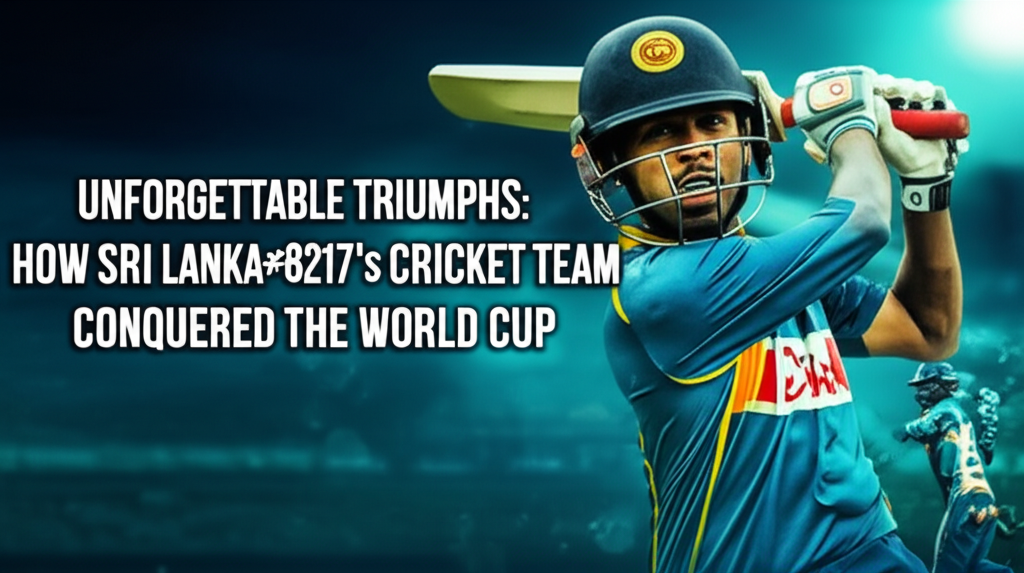
Unforgettable Triumphs: How Sri Lanka’s Cricket Team Conquered the World Cup
Cricket holds a special place in the hearts of millions, especially in countries like Sri Lanka, where the sport is almost a religion. Imagine the thrill, the cheers, and the tears of joy when this small island nation stunned the world by lifting the ICC Cricket World Cup in 1996. Today, we delve into the remarkable journey of Sri Lanka’s cricket team, exploring how they transformed from underdogs to champions in a memorable World Cup saga. You’ll learn about the pivotal moments, key players, and the strategies that propelled them to success, all while celebrating the spirit of Sri Lankan cricket.
In this article, we’ll not only recount the triumphs of the 1996 World Cup but also highlight the evolution of Sri Lankan cricket over the years. You’ll gain insights into the challenges faced by the team, the significance of their victories, and the legacy they left behind. If you’ve ever wondered how a nation of such humble beginnings in cricket could rise to dominate the international stage, you’re in for an enlightening read. We’ll cover the following sections:
- Understanding the Historical Context of Sri Lankan Cricket
- The Road to the 1996 World Cup
- Key Matches and Performances
- The Players Who Made History
- The Impact of the Victory
- Lessons Learned from Their Journey
- Frequently Asked Questions
Understanding the Historical Context of Sri Lankan Cricket
To appreciate Sri Lanka’s cricketing success, we must first understand its historical context. Cricket made its way to Sri Lanka in the early 19th century, introduced by British colonizers. Initially, it was a sport played among the elite, but it gradually gained popularity across all social strata. The formation of the Sri Lanka Cricket Board in 1932 marked a significant milestone, paving the way for the country’s participation in international competitions.
However, it wasn’t until 1975 that Sri Lanka made its debut in World Cup cricket. The team’s early years were filled with challenges, with limited resources and experience on the global stage. Yet, the persistence of players and the passion of fans laid the groundwork for future successes. By the late 1980s, Sri Lanka began to emerge as a competitive force, culminating in their first major achievement: winning the 1986 Asia Cup.
The Road to the 1996 World Cup
The journey to the 1996 World Cup was anything but straightforward. Leading up to the tournament, Sri Lanka faced a myriad of challenges, both on and off the field. The team was emerging from a civil conflict that had affected the nation deeply, and cricket served as a unifying force. The World Cup presented an opportunity for the team to bring joy and hope to a nation yearning for positivity.
The 1996 Cricket World Cup was co-hosted by India, Pakistan, and Sri Lanka, allowing the home team to enjoy a supportive fan base. Sri Lanka entered the tournament as one of the dark horses, with many considering them underdogs. However, the team had shown promise in the preceding years, with notable performances in bilateral series and the Asia Cup.
Forming a Solid Team
One of the crucial factors in Sri Lanka’s World Cup journey was the formation of a solid team. Under the captaincy of Arjuna Ranatunga, the squad was built around a blend of experienced players and emerging talents. The players included the likes of Sri Lanka’s legendary spin bowlers, Muttiah Muralitharan and Chaminda Vaas, alongside explosive batsmen like Sanath Jayasuriya.
Key Strategies and Game Plans
Ranatunga’s approach was characterized by aggression and a fearless mentality. He instilled a sense of belief in his players, emphasizing the importance of playing to win rather than merely competing. The team adopted an exciting brand of cricket, which included aggressive batting and innovative field placements that caught opponents off guard. This approach would soon pay dividends during the tournament.
Key Matches and Performances
The 1996 World Cup was a rollercoaster ride for Sri Lanka, with several key matches that defined their journey. Let’s explore some of these crucial encounters.
Group Stage Matches
Sri Lanka’s campaign kicked off with a match against Zimbabwe on February 22, 1996. The team secured a convincing win, with Sanath Jayasuriya scoring a stunning 88 runs, setting the tone for the tournament. They continued this momentum by defeating India and Pakistan, showcasing their potential and establishing themselves as serious contenders.
Quarterfinal Against India
The quarterfinal match against India on March 13, 1996, was one of the most memorable moments in Sri Lankan cricket history. The match was held at the Punjab Cricket Association Stadium in Mohali, India. Batting first, India posted a respectable total, but Sri Lanka’s bowlers, led by Vaas, restricted them effectively. The tension was palpable, but Sri Lanka chased down the target with remarkable composure, sealing their place in the semifinals.
The Semifinal Against the West Indies
In the semifinals, Sri Lanka faced the West Indies, a team with a rich cricketing legacy. This match was pivotal, as it could either confirm Sri Lanka’s status as a rising cricketing power or relegate them back to the underdog status. However, the Sri Lankans put on a dazzling display. Batting first, they set a challenging target for the West Indies, and their bowlers executed the game plan flawlessly, securing a berth in the finals.
The Final Showdown
The final took place on March 17, 1996, at the Gaddafi Stadium in Lahore, Pakistan, where Sri Lanka faced Australia, the reigning champions. Expectations were high, and the atmosphere was electric, with fans from both nations filling the stadium.
The Match Unfolds
Sri Lanka won the toss and elected to bat first, a decision that proved crucial. Their innings began with uncertainty, losing early wickets. However, the partnership between Arjuna Ranatunga and Roshan Mahanama stabilized the innings. They built a solid foundation, allowing the middle order, including the explosive Sanath Jayasuriya, to accelerate the scoring.
By the end of their innings, Sri Lanka had posted a total of 400 runs—a monumental score that set Australia a challenging target. The Australian batting lineup, renowned for its resilience, faltered against the Sri Lankan bowlers. Muttiah Muralitharan and Chaminda Vaas played instrumental roles in dismantling the Australian batting order, leading to an unexpected victory for Sri Lanka.
Celebration of Victory
When the final wicket fell, the stadium erupted in jubilation. Sri Lanka had achieved the unthinkable: they were the World Cup champions! The victory was not just a cricketing achievement; it symbolized hope and unity for a nation that had endured challenging times. The players were hailed as heroes, and their triumph became a source of national pride.
The Players Who Made History
While the team’s collective effort led to the World Cup victory, certain individuals shone brightly throughout the tournament. Here are some key players who played pivotal roles:
| Player | Role | Key Contributions |
|---|---|---|
| Sanath Jayasuriya | Opener | Explosive batting at the top order, crucial partnerships |
| Muttiah Muralitharan | Spinner | Key wickets in crucial matches, match-winning spells |
| Chaminda Vaas | Fast Bowler | Consistent wicket-taking ability, vital in the final |
| Arjuna Ranatunga | Captain | Leadership, strategic decision-making, and vital runs in the final |
The Impact of the Victory
The impact of Sri Lanka’s World Cup victory transcended cricket; it provided a much-needed boost to national morale. The win became a beacon of hope for a country grappling with socio-political challenges. This triumph not only united fans but also inspired a new generation of cricketers.
Moreover, this victory catalyzed the growth of cricket in Sri Lanka. It encouraged investment in the sport, leading to better infrastructure, training facilities, and youth development programs. The success of the 1996 World Cup was the foundation upon which future achievements were built, including the 2003 and 2007 World Cup campaigns.
Commercial Growth and Global Recognition
Post-1996, Sri Lanka emerged as a cricketing powerhouse, attracting international tours and sponsorship deals that flourished due to their newfound fame. The victory also prompted a surge in cricket-related activities, from grassroots initiatives to professional leagues, further solidifying Sri Lanka’s place in the global cricketing landscape.
Lessons Learned from Their Journey
The journey of Sri Lanka’s cricket team to World Cup glory provides valuable lessons that extend beyond the realm of sports. Here are some key takeaways:
- Unity in Diversity: Cricket united a divided nation, showcasing the power of sport in bridging gaps and fostering camaraderie.
- Believe in Your Team: The leadership of Arjuna Ranatunga demonstrated the importance of believing in your team and fostering a positive environment.
- Resilience: Overcoming challenges and setbacks is crucial for success, both in sports and in life.
- Adaptability: Being flexible and adapting strategies based on circumstances can lead to winning outcomes.
Frequently Asked Questions
What was Sri Lanka’s journey in the 1996 World Cup?
Sri Lanka entered the 1996 World Cup as underdogs and progressed through the group stages with impressive victories, including wins against India and Pakistan. They reached the quarterfinals, where they defeated India, followed by a semifinal victory over the West Indies. Finally, in the final, they triumphed against Australia, securing their first World Cup win.
Who were some key players in Sri Lanka’s World Cup victory?
Key players included captain Arjuna Ranatunga, who provided leadership; Sanath Jayasuriya, known for his explosive batting; Muttiah Muralitharan, a spin wizard; and Chaminda Vaas, a formidable fast bowler. Each of these players made significant contributions throughout the tournament.
How did the World Cup victory impact Sri Lanka?
The victory had a profound impact on Sri Lanka, uniting the nation and boosting morale during challenging times. It led to increased investment in cricket, improved infrastructure, and inspired a new generation of cricketers, establishing Sri Lanka as a major force in international cricket.
What was the significance of Arjuna Ranatunga’s leadership?
Arjuna Ranatunga’s leadership was pivotal to Sri Lanka’s success. His strategic decision-making, ability to inspire players, and belief in their potential fostered a strong team spirit, allowing the players to perform at their best under pressure.
How did Sri Lanka’s playing style evolve after the World Cup?
Post-1996, Sri Lanka adopted a more aggressive and innovative playing style. They focused on developing young talent and emphasized the importance of fitness, which contributed to their success in subsequent international competitions.
What lessons can be drawn from Sri Lanka’s cricketing success?
Sri Lanka’s cricketing success teaches valuable lessons about unity, resilience, and the importance of belief in teamwork. Their journey emphasizes the role of sports in promoting national pride and overcoming challenges, inspiring individuals and communities alike.
Conclusion
The story of Sri Lanka’s cricket team and their unforgettable triumph in the 1996 World Cup is one of hope, resilience, and national pride. Their journey from underdogs to champions teaches us that with determination, teamwork, and belief, anything is possible. As fans, we can draw inspiration from their story, recognizing that setbacks can lead to glorious comebacks, both in sports and in life.
If you’re passionate about cricket, or if you simply enjoy stories of perseverance and triumph, I encourage you to explore more about Sri Lankan cricket and its ongoing legacy. Join the conversation, share your thoughts, and let’s celebrate the spirit of sportsmanship together!





